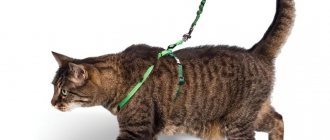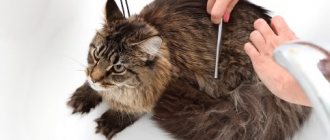Some owners of domestic cats do not consider it necessary to walk their animal on the street, which is very wrong and unfair. Fresh air and sunlight are good for animals. In addition, walking outside helps maintain physical fitness, strengthens the immune system and has a beneficial effect on the overall health of the pet.
If the owner is afraid to let the cat out on its own, he can walk it on a special leash. Such products are very common, and you can buy a high-quality leash for a cat at any pet store.
In the article we will look at the features of leashes for cats, what types there are, what to look for when choosing a leash, how to fasten a leash and accustom a cat to it, and in what cases it is contraindicated to walk your pet on a leash.
Why do you need a leash for a cat?
The leash is conveniently used for walking down the street, during long trips, for visiting exhibitions, a veterinary clinic and other outings with a domestic cat.
Advantages and disadvantages
Walking cats on a leash has its pros and cons. Let's take a closer look.
Pros:
- complete safety for the cat, allows you to control the pet’s movement and eliminate any dangerous situations when meeting stray yard cats and dogs;
- eliminates the risk of losing your pet while walking;
- peace of mind for the owner;
- brings the joy of the outdoors to indoor cats with limited access to the outdoors.
Minuses:
- not all cats quickly adapt to a new device that limits freedom of movement; while getting used to a leash, they can show their dissatisfaction, try in every possible way to free themselves from the accessory, break free and run away;
- an incorrectly selected leash that puts strong pressure on the neck can cause serious harm to the cat’s health;
- a low-quality leash can suddenly break during a walk, the cat can take advantage of the moment, run away and get lost.
The main disadvantages of using a cat leash can be eliminated by choosing the right accessory, made of high-quality and safe material. The owner needs to carefully fasten the leash and check the degree of pressure on the animal’s neck.
Walking rules
In order for a walk with a cat to go properly and not discourage the animal from going out into the fresh air, you must adhere to the following recommendations:
- Avoid noisy places. Any loud sound of a passing car or a child's scream can greatly frighten your pet, and therefore it is undesirable to walk on the street near the roadway or playground. It is better to carry your pet in your arms or in a carrier to the nearest park or any quiet place.
- Avoid contact with strangers. It is better not to allow stray animals near your pet to avoid fights or to avoid infection.
- The cat's safety comes first. When an unfamiliar and, in addition, aggressive dog runs towards you, it is not recommended to keep the cat on a leash. It is better to pick him up in your arms or give him the opportunity to climb the nearest tree. This way the purr will feel safe and will not be stressed.
- It's better to eat at home. It is important to ensure that the cat does not pick up food in its mouth on the street to avoid infection or poisoning.
Types of leashes for cats
The range of pet products includes special leashes for cats of different models, differing in functionality and material. We suggest considering the most popular types.
Roulette leash
The roulette leash is optimal for walking small kittens and big cats. The accessory is equipped with a handle and a latch-lock that allows you to fix the cable at the required length.
Leash-harness
A leash-harness is the most convenient device for walking cats, consisting of several elements: rings made of soft fabrics, connected to each other by a strap and fixed on the neck, chest and under the pet’s lower legs. A leash is attached to the harness. This device prevents the cat from escaping and does not put pressure on the neck.
Leash-belt
A leash-belt is a standard accessory with a collar, worn around the cat’s neck. The length of the leash is adjustable depending on the activity of the animal.
To dress or not to dress?
Using a collar will allow the owner to protect the animal from unnecessary food or prevent it from escaping.
Experienced breeders recommend including a clause on the use of a harness with a leash in the rules for walking cats. It will slightly limit freedom of movement, but will protect you from street “delicacies” and escape. It is important to remember that the collar is not needed to guide the kitten’s movements, but to provide insurance. If you constantly pull the leash, then domestic cats will not like it, they will simply lie down and not move. For walks, a special cat leash has been invented that can be attached to a harness. The accessory is placed on the pet’s body so that the straps wrap around the front legs and neck. The whole thing is fastened on the shoulder blades. The leash is usually attached there. When choosing an accessory for walking, you need to take into account that a finger should be placed between the pet’s body and the straps. Otherwise, the kitten will wriggle out of the leash.
The ideal material is nylon, which is easy to care for, durable and does not cause discomfort to the cat.
Among the models of harnesses, models “N” and “8” are considered the most comfortable.
How to choose a leash for a cat
When choosing a leash for a cat, the owner needs to pay attention to important criteria: product quality, material and length.
The recommended leash length is 2-2.5 m.
The leash should be of high quality, but not too dense and rigid. Cats are delicate animals; anything too rough can rub and injure the skin.
Materials for leashes
Leashes for cats are made of dense materials. The most common models are made of natural, artificial leather and canvas. They can be decorated with various decorations: stripes, rhinestones, beads, etc. The range is presented in a wide range of colors.
Is it worth taking your pet for a walk in an urban environment?
Many people don’t know how to train a cat to go for walks, or whether it’s even possible. If you have decided to walk your domestic cat, you should not immediately run to the store for a harness and leash.
First you need to clarify whether you can walk your pet. So, for example, if a cat lives in a large apartment or a private house, and its owners give it high-quality food and care for the pet’s fur and nails, then there is no need for walks, because the animal gets everything it needs at home.
Do not forget that most cats are extremely curious and after a few walks they may begin to show interest in the “outside world”. They will try at every opportunity to try to slip out of “imprisonment” and explore new territories longer. It also happens that a domestic cat loves walks so much that he asks to go outside.
It is worth accustoming your pet to walks from a young age, but not earlier than five months. For example, taking him out slowly on hot summer days to save the pet from overheating. This should be done in the evening, when it is already a little cooler outside. You can accustom your cat to walks in the country.
Walking domestic cats is especially recommended for animals with increased activity; for them this will be a great opportunity to release their energy. A summer cottage is truly the most ideal place to accustom a cat to the street.
In general, the answer to the question “is it possible to walk a cat?” directly depends on the character of the pet. Sometimes it happens that the cat asks to go for a walk on its own. However, we should not forget that some cats are not recommended to go outside. In order for an animal to be safely taken for a walk, it must have the following qualities:
- A neutered cat can go for a walk; cats must be sterilized before doing so. By the way, it is advisable to castrate a cat without the intention of taking him for walks, since an uncastrated animal can crap in the apartment. If a cat begins to shit, it is necessary to take him for castration. A castrated cat will behave more calmly.
- Adult animals that have received the necessary set of vaccinations.
- Regardless of gender, a pet that does not show aggression can walk outside.
INTERESTING TO KNOW: How to teach a cat to brush its teeth?
You should not take pets who have recently suffered a serious illness for a walk. It is also not recommended to walk overly timid animals that the owners have not been able to tame, as this can lead to disastrous consequences.
Rules for walking cats on a leash
When going for your first walk outside, take the cat in your hands and bring it to a place where there are few people and no other animals. Lower her to the ground and give her freedom of movement. Unlike dogs, a cat does not need to be controlled; it must chart its own walking route, and the owner only has to follow it, holding the leash, and stop it in a timely manner if the cat goes to a potentially dangerous place
Contraindications
There are some contraindications in which it is strictly not recommended to walk a domestic cat outside on a leash.
When not to walk your cat:
- If your cat is missing some vaccinations. There is a high risk of contracting infectious diseases while walking.
- After a serious illness and surgery. Until complete recovery.
- It is not recommended to walk cats during heat, otherwise the owner will have to save her from persistent fan cats, mostly street cats and strays.
- Pregnant and lactating cats.
- It is not advisable to walk overly aggressive animals on the street.
- Also, you should not take out on a leash old cats over 10 years of age who have never gone outside before.
A cat leash is a convenient accessory that allows you to walk your pet outside, controlling its movements and ensuring complete safety for your beloved tailed friend. Buy quality products for walking your cat. Wear the leash correctly and check that it is securely attached before going outside.
How to teach a cat to walk in the fresh air?
To prevent walking with your cat from causing unpleasant sensations, you first need to accustom the animal to a leash, following the instructions:
Introducing your cat to a harness will help you avoid stressful situations: just let him smell it and get used to the leash.
- For a positive reflex, it is recommended to take the harness out of the closet, show it to the cat and stroke it (give it a treat).
- When your pet has calmed down, put on the accessory, but without coercion or violence.
- Give the animal time to get used to the clothes. It is better at this moment to distract him with a game or food.
- After a couple of minutes, remove the device and hide it in the closet.
- When the pet gets used to the equipment, before going outside, walk around the apartment, following the cat.
Now you can train your cat to go for daily walks. It's better to do this early in the morning. Before placing the cat on the ground, you need to give him time to get used to the new environment and smells. When the first fear passes, you can walk your pet every morning for at least 10 minutes. When your pet gets used to it, you can take him out once a week if you wish.
How to train a cat to wear a harness
The safest way to walk a cat is to put a harness and leash on it. But everything is not as simple as it seems at first glance. The animal still needs to be accustomed to the collar. The fact is that felines cannot stand it when foreign objects are leaned against their body.
After purchasing a harness, you need to give it to your pet, let him smell it and play with it. A few days before the walk, you need to try on the harness. If your pet stands up straight, then you can go for a walk with him even the next day. However, most animals begin to spin around, trying in vain to get rid of their bonds. What to do and how to accustom a cat to a leash in this case?
In fact, everything is extremely simple. The main thing is not to give up and put the harness on the cat for a short time every day. Over time, the pet will become accustomed to the new clothes, and they will no longer bother him; subsequently, they can easily be put on before walking the animal outside.
INTERESTING TO KNOW: Using Vaseline Oil for Constipation in Cats
Walking equipment
Cats living in rural conditions from early childhood get used to taking walks only in the summer and on a free basis, remembering the path to the house. Living in an urban environment, it is more difficult for a cat to get used to the street environment, so the animal’s chance of getting lost is quite high.
In order for the pet to be able to walk outside without health consequences, the breeders came up with a special complex of several parts that is tied around the pet’s chest and front legs - a harness. Unlike a collar, from which any dexterous cat can get out in a matter of seconds, a harness sits securely on the pet’s body due to several attachment points. And even the most resourceful animal will not be able to get out of these “shackles.”
The harness, like the collar, is attached to the leash using a movable carabiner. This allows the pet to roam freely on the street, and the owner not to be afraid that his pet will slip away into the nearest basement.
What dangers can a cat face on the street?
Due to some of the dangers that pets can be exposed to when walking outside, some veterinarians are protesting against walking cats within city limits.
First of all, these are manifestations of stressful situations that can arise during a walk, as well as panic from the cat getting into an unfamiliar place. In this state, the kitten can easily break away from the leash and run away from the owner, after which the likelihood of finding the pet will be extremely small. Most likely, the animal will die under the wheels of a car or when meeting a pack of stray dogs.
Another danger that a cat can face on the streets of the city is the considerable likelihood of getting an infection.
There are many different parasites living outdoors that can infect a cat even with a small cut on the pad on its paw. But this disease can be avoided by simply completing the course of necessary vaccinations before accustoming your cat to the street.
The cat will constantly ask to go outside
Everyone who practices walking with cats claims that this will not happen. Of course, they like walking much more than sitting locked up, but they value the comfort, coziness and peace of home no less. Cats are able to get used to a routine and will look forward to walking just as dogs do.
And if the impatience of the latter can be caused by the fact that they simply want to go to the toilet, then cats do not have this problem either - the tray is always at their disposal. Therefore, your pet will live an ordinary life, but - I am absolutely sure of this - never for a minute ceasing to dream that you will finally be free and go on a delightful walk with her together.
Larisa Solodovnikova
When a cat needs a walk
Some pets are content to go out onto the balcony or watch what is happening through the window, while for others this is not enough. Felines are not dogs, and we are not talking about regular daily walks. In the private or dacha sector, no one restricts their movements, but in urban conditions the situation is somewhat different. When does it become necessary to take a cat outside? It is worth considering common situations:
- If your pet is too active and mobile, but in an apartment there are no opportunities for full-fledged games, then for a change you can take him outside. Here he can throw out excess energy and gain new impressions. But if the cat has no problems with this - there are toys, scratching posts, grass in the tray and other useful devices, then there is no need for walking. Moreover, having been on a walk, the pet may subsequently try to travel on its own, escaping through windows or doors.
- The second case is when pets walk to their heart's content all summer at the dacha or in the village and upon returning to the apartment, they may feel some discomfort. Of course, you shouldn’t let your freedom-loving pet roam freely in the city, but you shouldn’t completely refuse to visit the street either. In this case, it will be useful to take the cat out periodically.
- Another situation is heat and stuffiness, which can lead to overheating of the animal. Evening walks when there is no sun and the air temperature drops will help here.
- Also, lazy pets who have practically stopped playing and are increasingly lying around idly will benefit from walking. On the street they will have to be active.
In general, when deciding whether a cat needs such outlets, it is worth, first of all, assessing its needs, character, behavior and other nuances.
Should you walk your indoor cat?
The answer to this question depends on the age of the animal, its health status and the recommendations of the veterinarian. For example, sterilized cats suffering from obesity will benefit from walking. Hyperactive animals will also be happy about the promenade, and perhaps they will destroy the apartment less.
For whom walking is not recommended:
- kittens up to 5 months, because Until this age, some mandatory vaccinations cannot be given;
- pregnant cats;
- weakened animals after illness or during the recovery period after surgery;
- shy pets;
- unsterilized cats and uncastrated cats;
- elderly pets who have not been on walks before;
- You should not walk a domestic cat that is aggressive and intolerant of other animals; it is unlikely that it will enjoy the walk.











